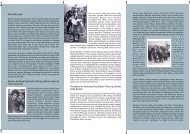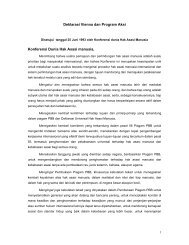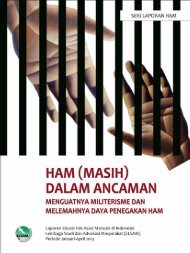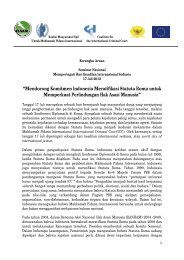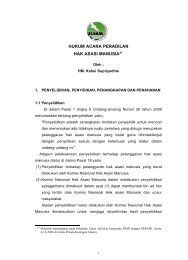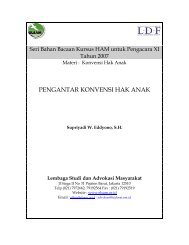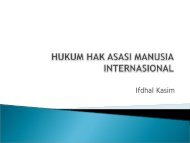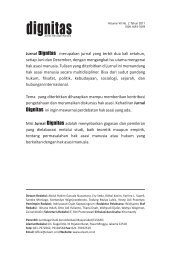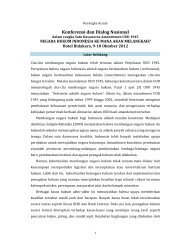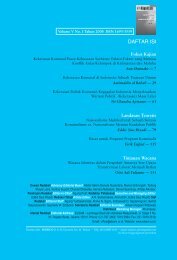Prosedur komplain DI bawah mekanisme dan sistem ... - Elsam
Prosedur komplain DI bawah mekanisme dan sistem ... - Elsam
Prosedur komplain DI bawah mekanisme dan sistem ... - Elsam
You also want an ePaper? Increase the reach of your titles
YUMPU automatically turns print PDFs into web optimized ePapers that Google loves.
Seri Bahan Bacaan Kursus HAM untuk Pengacara XTahun 2005Materi : <strong>Prosedur</strong> KomplainPROSEDUR KOMPLAIN <strong>DI</strong> BAWAHMEKANISME DAN SISTEMPERSERIKATAN BANGSA-BANGSAPatra M. Zein, S.H., LL.MLembaga Studi <strong>dan</strong> Advokasi MasyarakatJl Siaga II No 31 Pejatien Barat, Jakarta 12510Telp (021) 7972662, 79192564 Fax : (021) 79192519Website : www.elsam.or.id Email : elsam@nusa.or.id
Kursus HAM untuk Pengacara X, 2005Bahan BacaanMateri : <strong>Prosedur</strong> Komplain<strong>Prosedur</strong> Komplain di Bawah Mekanisme <strong>dan</strong> SistemPerserikatan Bangsa-Bangsa<strong>Prosedur</strong> komunikasi <strong>dan</strong> <strong>komplain</strong> dalam <strong>mekanisme</strong> <strong>dan</strong> <strong>sistem</strong> Perserikatan Bangsa-Bangsa (PBB) digunakan sebagai aktivitas pencarian judicial remedies di level internasional,bagi para korban kejahatan hak asasi manusia (HAM). Tujuannya, antara lain : mendapatkandorongan <strong>dan</strong> desakan komunitas di level global kepada Negara dalam pemenuhan hakasasi manusia (HAM). Walaupun aktivitas ini bersifat komplementer, penggunaan prosedurini dalam skala tertentu dapat memicu perbaikan-perbaikan situasi di level domestik.Karena pengaruh tersebut, intensitas pembawaan <strong>dan</strong> kampanye persoalan-persoalan HAMke PBB dilakukan ribuan orang setiap tahun melalui <strong>mekanisme</strong> yang ada. Tulisan ini akanmemberikan gambaran prosedur-prosedur yang seringkali digunakan untuk meminta PBBberbuat sesuatu atas problem pemenuhan HAM yang terjadi.A. <strong>Prosedur</strong> di Bawah Perjanjian <strong>dan</strong> <strong>Prosedur</strong> KhususKomplain di <strong>bawah</strong> hukum internasional HAM yang utama : dilakukan lewat alas acuanperjanjian-perjanjian (treaties) <strong>dan</strong> prosedur khusus yang disediakan Komisi HAM(Commission on Human Rights) – juga Komisi Status Perempuan (Commision on the Status ofWomen).<strong>Prosedur</strong> di <strong>bawah</strong> perjanjian, setidaknya mulai digunakan – <strong>dan</strong> dikembangkan <strong>mekanisme</strong>nya,sejak periode awal 1970. Komplain dilakukan di <strong>bawah</strong> aturan : Kovenan Internasional tentangHak-hak Sipil <strong>dan</strong> Politik (ICCPR); Konvensi Menentang Penyiksaan (CAT); Konvensi AntiDiskriminasi Rasial (CERD); <strong>dan</strong> Kovensi Anti Diskriminasi terhadap Perempuan (CEDAW).Sesuai dengan tajuk konvensi, <strong>komplain</strong> atau keluhan didasarkan pada klausa <strong>dan</strong> klasifikasiHAM yang ada di masing-masing perjanjian. Upaya ini ditujukan kepada sebuah komite quasijudicial,yang selanjutnya melakukan examinasi atas <strong>komplain</strong>-<strong>komplain</strong> yang diterimanya.Mekanisme yang sama berlaku juga untuk prosedur <strong>komplain</strong> kepada Komisi HAM <strong>dan</strong> KomisiStatus Perempuan, dimana kedua komisi ini melibatkan lembaga politik yang beranggotakanperwakilan dari Negara.Komplain yang diajukan pada komite diistilahkan sebagai “komunikasi” atau “petisi”. Masingmasingpetisi ini mempunyai form khusus yang meminta penyediaan informasi spesifiktermasuk korespondensi yang ada. Beberapa hal yang penting dalam menggunakan <strong>mekanisme</strong>prosedur, sebagai berikut :1. Memberikan informasi-informasi dasar personal;2. Mengajukan petisi dengan segera – walaupun tidak ada aturan soal batas waktu;Lembaga Studi <strong>dan</strong> Advokasi Masyarakat, ELSAM 1
Kursus HAM untuk Pengacara X, 2005Bahan BacaanMateri : <strong>Prosedur</strong> Komplain<strong>Prosedur</strong> pengajuan petisi : Jika petisi kita dieksaminasi Komite, kita akan mendapat advice ofregistration. Komite akan mengirimkannya ke Negara untuk meminta komentar atas petisi kita.Jika Negara memberikan komentarnya, pengaju petisi diberikan kesempatan untuk memberikankomentar balik. Jika Negara tidak mau merespon permintaan Komite, maka komite selanjutnyadapat mengambil keputusan berdasar petisi original kita.Petisi yang dieksaminasi Komite dengan melewati dua tahap : “admissibility” <strong>dan</strong> “merits”.Admissibility, kasus merujuk pada persyaratan formal dimana <strong>komplain</strong> kita harus jelas sebelumkomite memeriksanya, menyangkut antara lain : otorisasi pengaju petisi; berkesuaian denganprovisi-provisi dalam perjanjian (ratione materiae). Se<strong>dan</strong>gkan, “merits”, dimana kasusdipertimbangkan sudah dimengerti dengan baik, dimana komite memutuskan apakah hak-hakyang dijelaskan dalam petisi memang sudah dilanggar.Komite dibekali kapasitas untuk mengambil urgent action jika dianggap perlu. Mekanismeberdasarkan interim action yang dilakukan komite (“interim measures”) untuk mencegah problemHAM yang lebih serius, seperti urgent action atas kasus deportasi seseorang yang menghadapiresiko penyiksaan jika dilakukan. Pendeknya, “interim measures” ini digunakan berdasarkan isuyang mendesak <strong>dan</strong> tidak dapat ditunda atau diulang di masa selanjutnya. Jika kita ingin komitemempertimbangkan upaya ini, mesti secara eksplisit dimuat dalam petisi yang kita buat –dengan tentu saja menjelaskan dengan rinci <strong>dan</strong> dengan argumen yang kuat mengapa upaya inidiperlukan.Dalam keputusan yang nantinya dibuat Komite, kita juga dapat meminta Komite untuk tidakmemuat nama individu jika dianggap membahayakan kepentingan personal. Permintaan iniakan dipertimbangkan komite sebelum keputusan finalnya menjadi dokumen publik. Paskakeputusan dibuat, komite dapat mengun<strong>dan</strong>g Negara untuk memberikan informasi denganwaktu tiga bulan tentang langkah-langkah yang diambil berkaitan dengan problem HAM yangterjadi.B. <strong>Prosedur</strong> 1503<strong>Prosedur</strong> 1503, merupakan prosedur <strong>komplain</strong> tertua dalam <strong>sistem</strong> PBB. Digunakan di <strong>bawah</strong><strong>mekanisme</strong> Komisi HAM berdasarkan Economic and Social Council Resolution 1503 (XLVII), 27 Mei1970. Dalam prosedur ini, <strong>komplain</strong> lebih bersifat umum, ketimbang individual. Serta diajukandalam kasus-kasus yang kualifikasinya kejahatan berat. Di tahun 2000, terjadi amandemenprosedur (revised 1503 procedure) dengan tujuan untuk memfasilitasi lebih banyak dialog denganPemerintah <strong>dan</strong> menyediakan peluang debat yang efektif dalam Komisi ini.<strong>Prosedur</strong> 1503 dapat digunakan untuk Negara mana pun, tanpa harus mempertimbangkanapakah Negara ini telah meratifikasi perjanjian yang ada. Sekali kita mengajukannya, kita tidaklagi melakukan respon di tahapan selanjutnya. Komplain ditujukan ke Kantor Komisioner TinggiHAM (OHCHR) di Jenewa, Swiss. Komplain ini dieksaminasi oleh <strong>mekanisme</strong> Komisi HAM,level tertinggi dalam UN human rights machinery, yang dapat memberikan dorongan <strong>dan</strong> desakankepada Negara, karena sifat lembaga ini merupakan lembaga politik. Namun, kelemahannya,jika kita menggunakan prosedur ini, kita tidak mendapatkan informasi tentang putusan-putusanyang diambil, beserta alasan mengapa putusan semacam itu yang dijatuhkan. <strong>Prosedur</strong> 1503Lembaga Studi <strong>dan</strong> Advokasi Masyarakat, ELSAM 2
Kursus HAM untuk Pengacara X, 2005Bahan BacaanMateri : <strong>Prosedur</strong> Komplaindapat juga digunakan <strong>dan</strong> ditujukan kepada Komisi Status Perempuan, yang bertujuan untukmengidentifikasi trend global <strong>dan</strong> pola-pola problem hak asasi perempuan.Sebagai tambahan, Indonesia pernah dieksaminasi oleh Komisi HAM. Eksaminasi terjadi periode1978 – 1981 (sessi 34 th – 37 th ), <strong>dan</strong> periode selanjutnya, 1983 – 1985 (39 th – 41 th ). Eksaminasi,menyangkut aneksasi militer Indonesia ke Timor Leste.Lembaga Studi <strong>dan</strong> Advokasi Masyarakat, ELSAM 3
Kursus HAM untuk Pengacara X, 2005Bahan BacaanMateri : <strong>Prosedur</strong> KomplainTahun205Beberapa Istilah Umum dalam <strong>Prosedur</strong> Komplain di Bawah PerjanjianInternasional HAM 1accession/accede. "Accession" describes one method by which a state can choose to be bound bythe obligations in a treaty. The date the state deposits its instrument of "accession" with theSecretary General of the United Nations will determine the date the state becomes bound by thetreaty obligations. See also "ratification."admissible/admissibility. Admissibility refers to rules concerning the handling of individualcases. The human rights treaties, together with the Rules of Procedure of the relevant treatybodies, establish certain pre-conditions that must exist before a treaty body is entitled to considerthe merits of an individual complaint. If those pre-conditions are met, the complaint is"admissible" and the treaty body can proceed to consider the substance of the complaint. The"admissibility" phase of the decision-making process is the prior phase during which the treatybody considers whether the conditions of admissibility are met.amendment. The alteration of a treaty by subsequent agreement of the states parties. A treatymay provide for an amendment to come into force upon acceptance by a certain number orpercentage of states parties. An amendment may have to be separately agreed upon by a stateparty in order for it to become bound by the change.applicant. See "author" or "complainant".application. See "communication" or "complaint".author. The term used by the Human Rights Committee, CERD and CEDAW to refer to theperson who lodges the individual complaint of a violation of his or her rights. Also known as"complainant", "applicant" or "petitioner." See also "complainant".communication. The term used by the Human Rights Committee, CERD and CEDAW to refer toan individual complaint brought to the treaty bodies complaining of a violation of theindividual’s rights under the treaty. Also known as "petition", "complaint" or "application". Seealso "complaint".complaint. The term used by CAT to refer to an individual complaint brought to the treatybodies complaining of a violation of the individual’s rights under the treaty. Also known as"petition", "application", "communication". See also "communication".complainant The term used by CAT to refer to the person who lodges the individual complaintof a violation of his or her rights. See also "author", "applicant" or "petitioner."1 Lihat http://www.bayefsky.com/complain/2_glossary.phpLembaga Studi <strong>dan</strong> Advokasi Masyarakat, ELSAM 4
Kursus HAM untuk Pengacara X, 2005Bahan BacaanMateri : <strong>Prosedur</strong> Komplaingeneral comment. A general statement issued by the treaty body that provides gui<strong>dan</strong>ce on theinterpretation of procedural and substantive requirements of the treaty. The Committee onEconomic, Social and Cultural Rights, the Human Rights Committee, the Committee AgainstTorture, and the Committee on the Rights of the Child, refer to these statements as "GeneralComments". The Committee on the Elimination of Racial Discrimination and the Committee onthe Elimination of Discrimination Against Women refer to these statements as "GeneralRecommendations".general recommendation. A general statement issued by the treaty body that provides gui<strong>dan</strong>ceon the interpretation of procedural and substantive requirements of the treaty. The Committee onthe Elimination of Racial Discrimination and the Committee on the Elimination of DiscriminationAgainst Women refer to these statements as "General Recommendations". The Committee onEconomic, Social and Cultural Rights, the Human Rights Committee, the Committee AgainstTorture, and the Committee on the Rights of the Child, refer to these statements as "GeneralComments".interim measure. A measure that a treaty body asks a state party to take on an interim ortemporary basis, in order to avoid irreparable harm to the interests of the complainant, before thetreaty body has the opportunity to determine the merits of the complaint.merits. The substantive correctness, or otherwise, of a complainant’s allegation that a right underone of the treaties has been violated. The treaty body’s consideration of the merits follows itsconsideration of the issue of admissibility.monitoring body. See "treaty body".multilateral treaty. A treaty that has more than two states parties.non-governmental organization (NGO). A privately constituted organization.opinions. In the context of CERD, the Committee calls its findings on the merits of individualcomplaints "Opinions". See also "Views" and "Decisions"optional protocol. A separate treaty associated with a parent treaty, under which states parties tothe parent treaty may choose to undertake additional obligations. Not all states which haveratified the original treaty may have ratified the optional protocol.petition. See "communication" or "complaint".petitioner. See "author" or "complainant".plenary. The treaty body meeting formally as a whole, in accor<strong>dan</strong>ce with its formal rules ofprocedure.protocol. A kind of treaty. See "treaty", "optional protocol"Lembaga Studi <strong>dan</strong> Advokasi Masyarakat, ELSAM 6
Kursus HAM untuk Pengacara X, 2005Bahan BacaanMateri : <strong>Prosedur</strong> Komplainrapporteur. One member of the relevant treaty body that has been assigned certain special tasksto undertake on behalf of the treaty body. There are, for instance, special rapporteurs on NewCommunications (the Human Rights Committee), on Interim Measures (CAT), and on Follow-up(the Human Rights Committee).ratification/ratify. "Ratification" describes one method by which a state can choose to be boundby the obligations in a treaty. The date the state deposits its instrument of ratification with theSecretary General of the United Nations will determine the date the state becomes bound by thetreaty obligations. See also "accession."reservation. A statement made by a state when ratifying a treaty, in which it claims to exclude orto modify the legal effect of certain provisions of the treaty in their application to that state. See"declaration".secretariat. United Nations staff that are responsible, amongst many other tasks, for givingadministrative support to the treaty bodies. The Secretariat is formally headed by the Secretary-General of the United Nations. The staff of the treaty bodies is made up primarily of lawyers andcome from all regions of the world.signature. By signing a treaty, a state signals its intention to become bound by its provisions.However, a state does not actually become bound until it takes the further step of "ratification" or"accession". Until the state ratifies or accedes to the treaty, it is not a party to it, although it mustrefrain from acts that would defeat the object and purpose of the treaty. Sometimes a state willsign a treaty but then never take the further step of ratification or accession.special rapporteur. See "rapporteur".special procedures. These are human rights mandates which have been created by theCommission on Human Rights and which may be individuals or working groups that study aparticular human rights theme or the human rights record of a particular state.state. A country that is recognized as a separate sovereign entity by other states.state party. A state that has either ratified or acceded to a particular treaty, thereby becomingbound by its provisions.state report. A report submitted by a state party to the relevant treaty body on its progress ingiving effect to the rights recognized in the treaty. All of the human rights treaties require statesparties to submit states reports at regular intervals.state-to-state complaint. A procedure available under many of the human rights treaties(although usually on an optional basis) under which states parties to the relevant treaty cancomplain to the treaty body that another state party is not fulfilling its obligations under thetreaty.Lembaga Studi <strong>dan</strong> Advokasi Masyarakat, ELSAM 7
Kursus HAM untuk Pengacara X, 2005Bahan BacaanMateri : <strong>Prosedur</strong> Komplaintreaty. An agreement entered into by two or more states, which creates binding rights andobligations in international law. A treaty may go by many different names, such as "convention","covenant" and "protocol."treaty body. A committee of independent experts who are responsible for monitoring theimplementation by states parties of their obligations under the treaty. Each of the human rightstreaties has a treaty body associated with it. Also called a treaty "monitoring body"views. In the context of CCPR and CEDAW, their findings on the merits of individualcomplaints. See also "Opinions" and "Decisions"working group. A group of members of a particular treaty body that meet outside of the formalframework of committee meetings to perform certain functions that have been delegated to themby the treaty body.Lembaga Studi <strong>dan</strong> Advokasi Masyarakat, ELSAM 8




